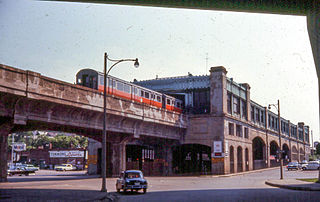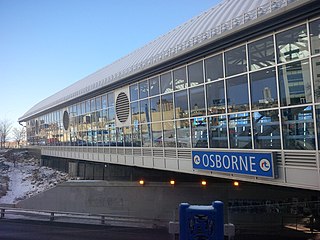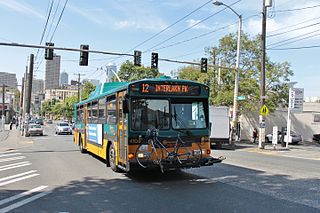
Rochester is a city in and the county seat of Olmsted County, Minnesota, United States. Located on rolling bluffs on the Zumbro River's south fork in Southeast Minnesota, the city is the home and birthplace of Mayo Clinic.

The Silver Line is a system of bus routes in Boston and Chelsea, Massachusetts, operated by the Massachusetts Bay Transportation Authority (MBTA). It is operated as part of the MBTA bus system, but branded as bus rapid transit (BRT) as part of the MBTA subway system. Six routes are operated as part of two disconnected corridors. As of 2019, weekday ridership on the Silver Line was 39,000.
Metro Transit is the primary public transportation operator in the Minneapolis–Saint Paul area of the U.S. state of Minnesota and the largest operator in the state. Metro Transit has previously been ranked as one of the best public transit systems in the United States. In 2023, the system had a ridership of 44,977,200, or about 145,600 per weekday as of the fourth quarter of 2023.

The Rochester Industrial and Rapid Transit Railway, more commonly known as the Rochester subway, was a light rail rapid transit line in the city of Rochester, New York that operated from 1927 to 1956. The subway was constructed in the bed of the old Erie Canal, which allowed the route to be grade-separated for its entire length. Two miles (3.2 km) of the route through downtown were constructed in a cut-and-cover tunnel that became Broad Street, and the only underground portion of the subway. The Rochester Subway was designed to reduce interurban traffic on city streets, and to facilitate freight interchange between the railroads. The line was operated on a contract basis by New York State Railways until Rochester Transit Corporation (RTC) took over in 1938. The last day of passenger service was June 30, 1956. Portions of the right-of-way were used for expressway construction, while the rest was abandoned and filled in over the years. The largest remaining section is a stretch of tunnel under Broad Street from Exchange Street to the intersection of Court Street and South Avenue.

The Washington Street Elevated was an elevated segment of Boston's Massachusetts Bay Transportation Authority subway system, comprising the southern stretch of the Orange Line. It ran from Chinatown through the South End and Roxbury, ending in Forest Hills in Jamaica Plain, Boston.

Winnipeg Transit is the public transit agency, and the bus-service provider, of the City of Winnipeg, Manitoba. Established 141 years ago, it is owned by the city government and currently employs nearly 1,600 people—including approximately 1,100 bus drivers.
The Relief Line was a proposed rapid transit line for the Toronto subway system, intended to provide capacity relief to the Yonge segment of Line 1 and Bloor–Yonge station and extend subway service coverage in the city's east end. Several plans for an east–west downtown subway line date back to the early 20th century, most of which ran along Queen Street.
The Metro Purple Line, formerly known as the Rush Line Corridor, is a proposed bus rapid transit service that would run from Union Depot in downtown Saint Paul to the northeastern suburbs of Saint Paul. Along the corridor's 21 proposed stations there are 106,000 jobs within a 10-minute walk. The project is currently in an environmental analysis phase with further development, engineering, and construction expected to take at least six more years. Service would run 7-days a week with 10-minute headways in peak periods and 15-minute service at most other times. The corridor was named the Rush Line because it was originally planned to end in Rush City, Minnesota. After using the color purple since 2017, the route was officially named the Purple Line and became part of the Metro network on July 14, 2021.

The Metro Orange Line is a bus rapid transit line in the Twin Cities, Minnesota operated by Metro Transit. The line operates primarily along Interstate 35W from downtown Minneapolis through Richfield and Bloomington before terminating in Burnsville, Minnesota. The Orange Line provides access to 198,000 jobs with roughly a quarter of them outside downtown Minneapolis. The route serves a mix of stations located in the center of the highway, stations near highway exits, and on-street stations. The line has features typical of bus rapid transit systems with off-board fare payment, articulated buses with extra doors, stations with improved passenger amenities, and transit-only bus lanes on portions of the route.

The HealthLine is a bus rapid transit (BRT) line run by the Greater Cleveland Regional Transit Authority in Cleveland and East Cleveland, Ohio, United States. The line runs along Euclid Avenue from Public Square in downtown Cleveland to the Louis Stokes Station at Windermere in East Cleveland. It began operation on October 24, 2008. Its current name was the result of a naming rights deal with the Cleveland Clinic and University Hospitals of Cleveland. The HealthLine is denoted with a silver color and abbreviated simply as HL on most RTA publications.

Winnipeg RT is a bus rapid transit system of Winnipeg Transit in Winnipeg, Manitoba, Canada, currently consisting of the Southwest Transitway. Future expansions are in the planning stages, consisting of an Eastern Corridor connecting downtown to Transcona and a West-North Corridor connecting St. James with Downtown and West Kildonan.

Rapid is the brand name given to the bus rapid transit system in San Diego County, California. The system serves nearly half the county, operating mainly on the HOV lanes on Interstates 15 and 805, with most of the stops also served by other routes. In addition, there are stations, dubbed as CenterLine in the medians of Interstate 15, Park Boulevard in San Diego and on East Palomar Street in Chula Vista, that are designed in a similar manner to the light rail stations. The system operates with a dedicated fleet, although buses from the Mainline fleet are regularly substituted. The system is administered, built and managed by San Diego Association of Governments (SANDAG) and is operated as part of the San Diego Metropolitan Transit System (MTS).

The City Line is a bus rapid transit (BRT) line in Spokane, Washington, United States, that opened on July 15, 2023. The 6-mile-long (9.7 km) route, which is operated by the Spokane Transit Authority, runs from Spokane's Browne's Addition neighborhood, through Downtown Spokane and the University District, including the WSU Health Sciences campus and Gonzaga University, before ending at the Spokane Community College campus in the Chief Garry Park neighborhood. The project budget as of 2023 was $92.2 million.

The RapidRide G Line is a future RapidRide bus service in Seattle, Washington, operated by King County Metro on Madison Street between Downtown Seattle and Madison Valley. The line is projected to open for service on August 31, 2024, and cost $133.4 million.
The Green Line, also known as Route 203 is a light rail (LRT) line under construction in Calgary, Alberta, Canada. The line will run between Calgary's north-central and southeastern boundaries, connecting with the Red Line and Blue Line in the city's downtown. The Green Line is the largest public infrastructure project in Calgary's history and will be the first rail line in the city to operate low-floor trains. When completed, the Green Line will comprise 29 stations spanning 46 kilometres (29 mi). This will bring the total number of CTrain stations in Calgary to 74.

The Metro C Line is a bus rapid transit line in Brooklyn Center and Minneapolis, Minnesota operated by Metro Transit. The line is part of Metro Transit's Metro network of light rail and bus rapid transit lines. The route operates from the Brooklyn Center Transit Center along Penn Avenue and Olson Memorial Highway, terminating in downtown Minneapolis. The route is analogous to the existing Route 19 and is projected to increase ridership on this corridor from 7,000 to 9,000 by 2030. Eventually, part of its route will shift south to Glenwood Avenue from Olson Memorial Highway.

The Metro D Line is a bus rapid transit line in Minneapolis-Saint Paul, Minnesota. The 18.5-mile (29.8 km) route primarily operates on Fremont and Chicago Avenues from Brooklyn Center through Minneapolis to the Mall of America in Bloomington. As part of BRT service, the D Line features "train-like amenities" including improved station facilities, off-board fare payment, modern vehicles, fewer stops, and higher frequency. The current alignment would substantially replace the existing Route 5, the highest ridership bus route in Minnesota.

Frequent Express (FX) is a high-capacity bus service with some bus rapid transit (BRT) features in Portland, Oregon, United States. Operated by TriMet as FX2–Division, the 15-mile (24 km) route runs east–west from 5th & Hoyt on the Portland Transit Mall in downtown Portland to Cleveland Avenue Park and Ride in Gresham via Division Street. It connects Portland City Center, Portland State University (PSU), South Waterfront, Southeast Portland, and central Gresham, with transfers to MAX Light Rail and the Portland Streetcar.

The Metro B Line is an under construction bus rapid transit route in Minneapolis and St. Paul. The route will operate mostly on Lake Street in Minneapolis before crossing the Mississippi River into St. Paul and operating mostly on Selby Avenue and ending in downtown St. Paul. The route was identified in Metro Transit's 2014 Arterial Transitway Corridors Study as one of eleven local routes to be upgraded to bus rapid transit. The route will have "train-like" features to speed up service, such as signal priority, all-door boarding, further stop spacing, and specialized vehicles. Planning and design was completed in 2021, with construction beginning in May 2023. The line will join a number of Metro Transit's future Metro system lines, as well as the currently operating A Line, C Line, and D Line. Full funding for the line was secured in October 2020 with a final $35 million from the state of Minnesota.

Ramp A/7th Street Transit Center is a bus rapid transit station in downtown Minneapolis, Minnesota. The transit center is a southbound station on the Metro C Line and D Line, as well as several local routes. The transit center is located inside of Ramp A, a 3,637 stall parking ramp built over sunken Interstate 394.
















